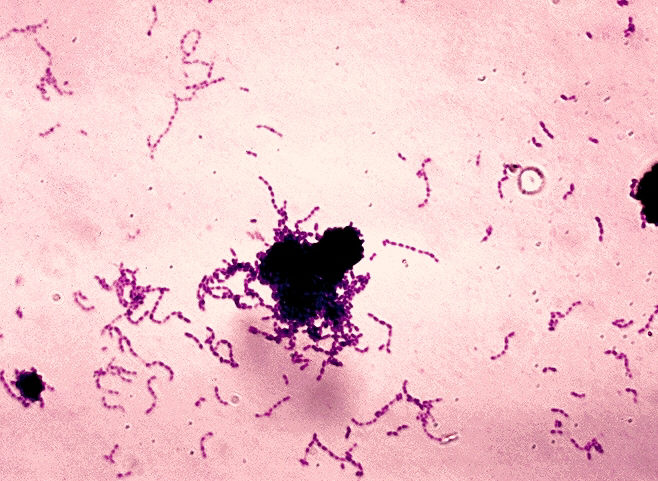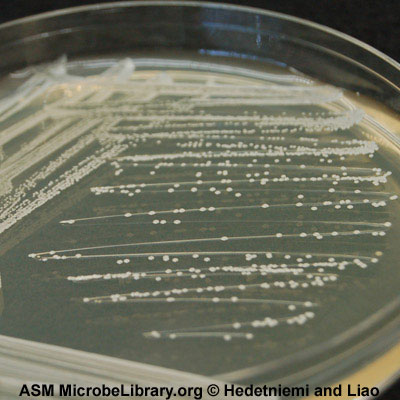Microbewiki:''Streptoccus mutans'' and Dental Caries
PROFILES IN BACTERIOLOGY:
What is Streptococcus mutans?
Contents
[Classification]
[S. mutans and dental caries]
[Biofilm]
[S. mutans and early childhood caries]
[References]
Gram Stain of Streptoccus mutans. CDC/Dr. Richard Facklam. 1975.
Streptococcus mutans is a Gram positive streptococcus bacterium that inhabits human teeth and has been demonstrated to be the primary bacterial cause of dental caries (commonly known as cavities). S. mutans is part of the normal flora or normal microbiota of humans, so the presence of S. mutans in the mouth does not automatically cause dental caries.
Here is a culture of Streptococcus mutans grown in the laboratory:
LA plate streaked with Streptococcus mutans and incubated at 37ºC for 24 hours
Hedetniemi, Kevin and M-K, Liao. 2006. Luria Broth (LB) and Luria Agar (LA) Media and Their Uses: Streptococcus mutans. Furman University, Greenville, SC. http://www.microbelibrary.org/index2.php?option=com_resource&controller=article&Itemid=73&article=3033. 25 April 2013.
Want to know more about how S. mutans causes cavities?
See the [S. mutans and dental caries] page.
References:
- Image 1043, Public Health Image Library. CDC website.
http://phil.cdc.gov/phil/details.asp?pid=1043
- Tortora, G. J., Funke, B. R., and Case, C. L. Microbiology: An Introduction, Tenth edition. 2010 Pearson Education, Inc.
Classification
h2 Classification of Streptococcus mutans
Streptoccus mutans is a gram positive bacterium.
- Domain: Bacteria
- Phylum: Firmicutes (low G-C, Gram + bacteria)
- Class: Bacilli
- Order: Lactobacillales
- Family:Streptococcaceae
- Genus: Streptococcus
- Species: Streptococcus mutans
Note: Historically, Streptococcus mutans has sometimes been categorized in the group mutans Streptococci, a group of oral bacteria discovered concurrently. More recently, it has been realized that the original researchers had actually cultured multiple species that were not as related as they believed.
For more explanation on the various oral bacteria related to Streptococcus mutans, follow this link to a tutorial:
http://www.ncl.ac.uk/dental/oralbiol/oralenv/tutorials/streps.htm
References:
- Allmann, Amber. Streptococcus mutans. Wiki.
http://bioweb.uwlax.edu/bio203/s2007/allmann_ambe/
- Image 1043, Public Health Image Library. CDC website.
http://phil.cdc.gov/phil/details.asp?pid=1043
h2 The role of Streptococcus mutans in dental caries
h3 What are dental caries?
- dental caries areas of decay brought on by bacterial infections of the teeth
- dental caries are considered to be an infectious disease
{image:worksite:/Wiki figures/Toothdecaystages.jpg|Toothdecaystages.jpg}
Open content from WikiEducator.org
This figure shows the progression of dental caries from affecting only the outer surface of the tooth (enamel caries) to more advanced forms of decay in which inner tooth structures are also affected. Different species of bacteria are involved in these stages of dental caries. ~~Streptoccus mutans~~ is associated with the early stage, enamel caries.
h3 How do caries form?
- ~~Streptococcus mutans~~ exist as part of the normal flora of the mouth
- ~~S. mutans~~ adhere to the teeth as part of a [biofilm]
- other species of bacteria join this mass of ~~S. mutans~~ bacteria on the teeth
* ~~Actinomyces~~ attaches by extensions called fimbriae to the dextran (a sugar) that ~~S. mutans~~ secretes
- ~~S. mutans~~ metabolizes sucrose (table sugar) and secretes lactic acid as a byproduct
- lactic acid can demineralize the teeth, leading to indentations in the enamel that are called cavities
- ~~S. mutans~~ is involved in enamel caries, but other bacteria are more abundant in later stages of caries
References:
- Oral Health in America: A Report of the Surgeon General. Ch. 3: Dental and Periodontal Infections.
http://www.nidcr.nih.gov/datastatistics/surgeongeneral/sgr/chap3.htm
- Tortora, G. J., Funke, B. R., and Case, C. L. ~~Microbiology: An Introduction~~, Tenth edition. 2010 Pearson Education, Inc. p. 81, 163, 431, 707-708


